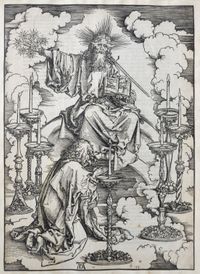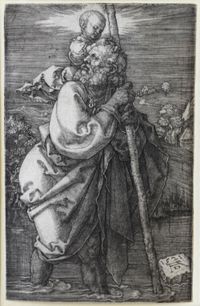Albrecht Dürer's prolific and innovative use of printmaking techniques saw him gain attention amongst humanist scholars and the educated elite. His close friend Willibald Pirckheimer advised Dürer on developments of the Italian Renaissance and suggested subjects for his works that would have broader appeal. Print was Dürer's favoured medium, partly for its comparative profitability to painting and its ability to be more readily and widely disseminated across Europe—with paintings usually limited to private collections in select cities.
Read MoreDürer's woodcuts such as Saint Jerome (1492) and Hercules (c. 1496) tended towards a more Gothic style, while his engravings reflected the influence of Italian Renaissance principles. Adam and Eve (1504), St Jerome in the Wilderness (1512), and Melencolia I (1514) are some of many engravings by Dürer that employ his distinct method of crosshatching and fine lines to create a sense of tone and dimension more similar to painting than traditional woodcuts. His skilled draughtsmanship paired with a sophisticated use of iconography elevated Dürer's reputation and the broader appeal of the print medium. Dürer's reputation as a printmaker informed the Holy Roman Emperor Maximilian I's conception of the Triumphal Arch (1515–1517), a monumental woodcut print commissioned by the emperor of which Dürer was the chief designer.
Dürer's drawings span a broad range of subjects, including portraits, Biblical narratives, drapery, costumes, and hands. His drawings were executed in pencil, ink, or silverpoint. He also produced watercolour studies of landscapes, animals, and nature. The Castle at Trento (1495) demonstrates the artist's skilled rendering of architecture in watercolours, while the pen-and-ink drawing Praying Hands (1508) shows a lifelike rendering of tone and proportion.
Dürer demonstrated sophisticated draughtsmanship skills from an early age, exemplified in his Self-portrait (1484) in silverpoint, produced at age 13. The oldest known drawing by the artist and one of the oldest surviving self-portraits in European art history, the image illustrates Dürer's ability to translate tone and drapery in a naturalistic representation. The evolution of Dürer's portraiture can be appreciated in Self-portrait (1500), the last of Dürer's series of three painted self-portraits, which depicts an austere frontal view of the artist in a Christ-like representation.
Dürer's Young Hare (1502) is one of the artist's most recognisable works. The observational painting in watercolour and bodycolour was revolutionary for its near-photographic rendering of texture, proportion, and light, with fine details such as whiskers, fur, and the reflection of light in the rabbit's eyes.
Though the Lutheran church generally frowned upon religious artworks, Dürer produced several religious paintings in his lifetime, as well as portraits of family members and other figures. Dürer also continued to sketch throughout his life, typically carrying a sketchbook on his many travels beyond Nuremberg, in which he would make observational drawings.


